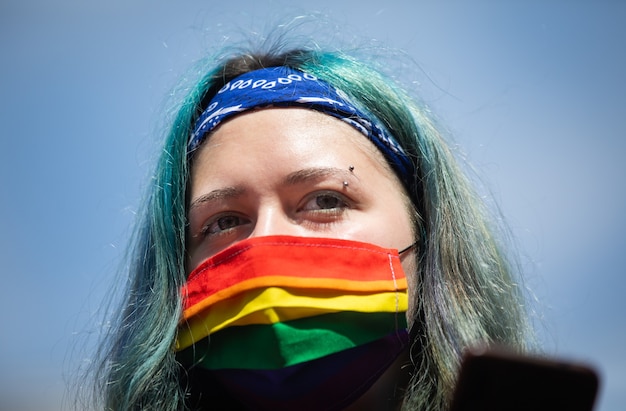The other day I stumbled across a rather broad topic on the internet that made me shake my head: facial recognition at LGBTQ+ events. Yes, you read that right! As I poured my coffee, I asked myself how much technological progress is actually going on in the areas where we all actually want to have fun. It all sounded like science fiction at first glance, but it's now a reality - with all its advantages and disadvantages.
If you're wondering whether these are all just crazy conspiracy theories or whether our privacy is really at stake, then you've come to the right place. Because today I'm going to take you on a little journey through the topic: **Face recognition at LGBTQ+ events**. How does it work? Why is this technology used? And what does it mean for our freedom, our privacy and the rights of the community?
What is actually behind facial recognition at LGBTQ+ events?
First of all, what is it anyway? Facial recognition is a technology that uses special algorithms to identify people from photos or live video without the need for their name or ID. Pretty cool, right? Or maybe also pretty scary? Especially when we use this technology in an environment as important to us as Pride marches or other LGBTQ+ events, it raises a lot of questions: How much privacy is left? Can data be misused? And what is actually behind such endeavours?
In recent years, there have been repeated reports of governments and private companies using facial recognition to monitor people. This is particularly explosive in connection with LGBTQ+ events, where anonymity plays a major role for many. For members of the community who are afraid of discrimination or persecution, identification through facial recognition can become a real nightmare. After all, it is not always clear who is behind the digital eyes that track their movements.
Why do authorities and organisations use facial recognition at LGBTQ+ events?
The use of this technology at Pride parades or similar events usually has a double bottom: on the one hand, it is claimed to increase the safety of the participants. Malicious attacks, assaults or even terrorism are supposed to be prevented. On the other hand, there are critics who strongly question all of this. They warn of a massive invasion of privacy that could jeopardise social cohesion.
A frequently discussed point is the so-called **freedom of data**: Who has access to the images and data collected? Will this data later be used for other purposes, for example for advertising, surveillance or even police measures? Especially in countries where rights and freedoms still have a lot of room for improvement, there is a growing fear that facial recognition at LGBTQ+ events will be **abused** - against the community itself!
Legal developments and social discussions
In Europe, especially in the European Union, the discussion about data protection and privacy is quite lively when it comes to such technologies. The General Data Protection Regulation (GDPR) is intended to provide a framework and prevent abuse. However, reality shows that regulations are often difficult to enforce, especially when companies or states pursue their own interests. Civil rights organisations are therefore calling for a clear ban or at least strict controls on the use of facial recognition at LGBTQ+ events.
On the other hand, supporters argue: "Such technologies could help to protect human lives." However, they often forget that the danger lies in misuse and that the boundaries between protection and surveillance are blurred. It is therefore quite a balancing act between security and freedom.
What does this mean for the future? Opportunities and risks
Whether we like it or not, developments are continuing. Facial recognition at LGBTQ+ events is just one example of the increasing use of artificial intelligence in public spaces. It is up to us to remain critical and question which technologies are really necessary and where the line to surveillance is being crossed.
Of course, there are also positive aspects: Improved security, easier location of missing persons and more control in crisis situations. But we must not ignore the downsides. There needs to be an open debate about what data can be collected and how we can protect our privacy.
In the long term, society could benefit from more transparency and clear regulations. And we should all remain vigilant so as not to steer into a world where facial recognition at LGBTQ+ events victimises all privacy just because someone thinks security is everything.
Looking ahead: what can you do?
If you are really concerned about this issue, there are a few simple things you can do right now: Inform yourself about your rights, be critical when using new technologies and demand more transparency from authorities and event organisers. Because only if we all have a say can we create a society in which privacy and security go hand in hand - without fear of uncontrolled facial recognition.
And let's be honest: a little privacy is the best gift we can give ourselves in this data-crazy world, isn't it? After all, life should be fun without a camera constantly being pointed at us just because "technology" wants it that way.
Conclusion: Technology yes, but with brains!
The issue of '**face recognition at LGBTQ+ events**' divides opinion. It can bring security, but it can also restrict freedom and encourage abuse. It is important that we remain vigilant and actively campaign for data protection and human rights. This is the only way that technology - whether at Pride or elsewhere - can be a tool for positive development, not for surveillance in the dark.
In the end, it all comes down to this: Technology undercover or with an open visor? Decide which world you want to live in - a world in which privacy is still worth something.
